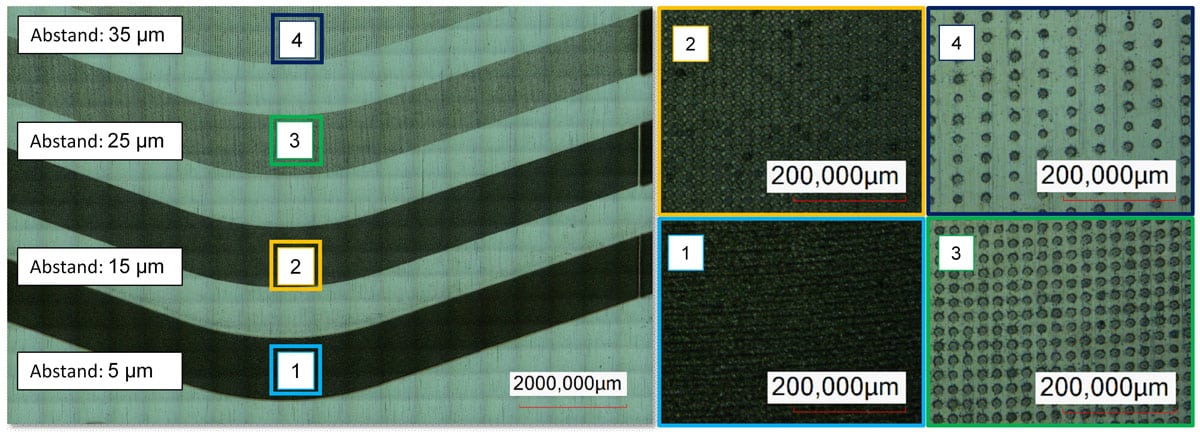
Innovative cooling concept for fuel cells
Hydrogen fuel cell systems have significant advantages over established technical solutions for both motive and stationary applications. They are set apart particularly by their qualities of zero-emission operation, long life and high achievable efficiencies. However, their relatively high purchase price often deters potential users. To reduce costs, bipolar plates intended for mass-production are to be designed with as little material as possible. Thanks to an innovative cooling concept, applications can be made not only less expensive but also smaller and lighter.
Reducing the installation space increases the power density of the system and raises the heat flow density. This creates huge challenges when it comes to efficiently controlling the temperature of fuel cell systems. In addition to established air and liquid cooling solutions, cooling that occurs through the change in the coolant’s state is an approach that shows much promise. By purposefully configuring the geometric surface properties of bipolar plates, greater amounts of heat can be dissipated while also enabling a targeted adjustment of the temperature distribution along the bipolar plate. The HZwo:FRAME joint project entitled “Innovative cooling systems for fuel cells” has successfully managed to develop a cooling concept based on the phase transition of a coolant and to demonstrate its function on a laboratory scale.
Greater heat transfer needed
Effective and precise control of temperature is vital for the efficient operation of a fuel cell system. Commercially available fuel cell stacks currently offer two cooling methods: air cooling and liquid cooling [1].
Air cooling is characterized principally by its simplicity of design. The technical complexity is much lower compared with liquid-based cooling systems since no other elements are required aside from a fan. Its possible uses are limited chiefly by the relatively small quantity of heat that can be dissipated. Furthermore, air-cooled systems commonly lead to highly uneven temperature distribution within the fuel cells which can negatively affect their efficiency and long-term stability. Most stacks with a power output of under 5 kilowatts are actively air-cooled, for example in stationary applications.
Liquid cooling has established itself as the prevalent form of temperature control in fuel cell stacks with a total electrical output of more than 5 kilowatts, for instance in vehicles. In liquid-cooled fuel cell systems, the coolant is pumped around a circuit through special cooling channels which are integrated into the fuel cells. The heat that is absorbed here must then be transferred back to the environment in a downstream heat exchanger.
Current developments are increasingly focused on thin metal bipolar plates as this type of plate lends itself to future mass production at favorable cost. At the same time, the power density of fuel cells can be increased, thus opening up new application areas and creating possibilities for miniaturizing fuel cell systems. Given this shift in development, the aforementioned conventional cooling solutions, based on convection alone, will be insufficient in future to dissipate the necessary amount of heat via the surface areas that remain.
Two-phase cooling (also referred to as evaporative cooling) makes it possible to reach the high heat flow densities required, i.e., the flow of thermal energy relative to the unit area and cooling time for miniaturized fuel cells. This cooling process exploits the effect whereby a large amount of energy – the latent heat of evaporation – is needed when the coolant changes into a gaseous state. This energy is extracted from the fuel cell during the phase transition on the surface of the bipolar plates, thus helping significantly to cool the fuel cell. Since this powerful cooling concept relies on low volume flows of coolant, the output required from the necessary peripheral equipment, such as pumps, can be reduced considerably when compared with air or liquid cooling [2].
Laser cutting
The research was motivated particularly by the huge potential that evaporative cooling offers in terms of the efficient heat management of fuel cell systems. Here, the attention was focused on metal bipolar plates since they are a key functional element in the fuel cell. As part of the development process, design concepts for the new cooling method had to be devised and implemented, such as the simulation-based calculation of optimized coolant flow or the design of durable gaskets. In the end, it was decided to produce the metal bipolar plates from a 100-micron-thick initial sheet using forming techniques and to then modify the plates to meet the requirements of the new cooling concept.
One project objective was to achieve a homogeneous temperature distribution on the bipolar plate. To reach this goal, a suitable surface functionalization was chosen as the method for influencing the heat transfer coefficient. This technique was applied by introducing microstructures in the form of single-pulse laser cuts using laser beam machining. The effect of these kinds of microstructures is, firstly, to enlarge the real surface area of the bipolar plate and, secondly, to increase the number of nucleation sites for bubble formation during the phase transition.
In connection with this, the microstructure density (number of microstructures per unit area), because of its relevance as a design parameter, was investigated by varying the spatial gap between the individual pulse cuts. Abb. 1 shows the results of microstructuring the test pieces at different pulse gaps of between 5 microns and 35 microns.
Proven at lab level
A laboratory testing area was developed and set up to examine the heat transfer of the modified bipolar plates (see fig. 2). The test fixture was designed so that the technical conditions would correspond to those of a real-world application and could be altered within a range of realistic load variations. A transparent process chamber and a bipolar plate envelop the cooling channels, thus enabling visual identification of flow and boiling processes occurring in the coolant. In addition, three shielded thermocouples were positioned centrally in the direction of flow and spaced evenly across the bipolar plate. These were used to measure the temperature distribution in the coolant.

Fig. 2: Test fixture: process chamber with integrated bipolar plate and temperature sensors
The experiments used different types of plate, including a stamped reference bipolar plate and a laser-structured, coated bipolar plate. The microstructure density was varied depending on the direction and length of flow in order to achieve the most even temperature distribution possible along the direction of flow.

Fig. 3: Structured bipolar plate with microstructure density reducing in the flow direction (left); detailed view of wave structure (center); detailed view of microstructuring (right)
The test fixture was used to run experiments to demonstrate and investigate the influence of surface functionalization on phase transition behavior. Here, the boiling processes on the structured surface were less distinctive than on the unstructured reference plate (see fig. 4). In addition, the measurements using the temperature sensors confirmed that the maximum temperatures arising could be lowered through surface functionalization of the bipolar plate. What is more, the temperature distribution along the direction of coolant flow was much more even: The temperature ?T along the structured and coated plate was lower for all parameter sets examined in comparison with the reference bipolar plate.

Fig. 4: Results of the visual examination: intensity of bubble movement (dark-blue areas) in the flow field of the reference plate (top) and the structured and coated plate (bottom) for the process parameters (incoming coolant temperature and heat flow density of the bipolar plate): 78 °C and 0.5 W/cm2 (left); 78 °C and 2 W/cm2 (right)
It was thus possible to prove that the thermodynamic properties of bipolar plates, particularly in the evaporation zones, can be influenced and modified through microstructuring. The project’s findings represent a further step toward achieving fuel cell stacks that are both cost-effective and space-efficient.
About the project
The project gathered essential and relevant knowledge for the design and technical realization of a fuel cell stack with metal bipolar plates based on the evaporation principle. The work was validated under realistic conditions. The following project partners worked in cooperation to achieve the project objectives: WätaS, Fischer Werkzeugbau, CeWOTec, the Department of Micromanufacturing Technology and the Department of Advanced Powertrains at TU Chemnitz.
Funding and project management: European Regional Development Fund (EFRE) / Sächsische Aufbaubank (SAB)
Reference(s)
[1] A. Fly and R. H. Thring, A comparison of evaporative and liquid cooling methods for fuel cell vehicles, Int. J. Hydrogen Energy, vol. 41, no. 32, pp. 14217–14229, 2016, ISBN: 0360-3199, ISSN: 03603199, DOI:10.1016/j.ijhydene.2016.06.089
[2] G. Zhang and S. G. Kandlikar, A critical review of cooling techniques in proton exchange membrane fuel cell stacks, Int. J. Hydrogen Energy, vol. 37, no. 3, pp. 2412–2429, Feb. 2012, ISSN: 03603199, DOI:10.1016/j.ijhydene.2011.11.010
Authors:
Igor Danilov, M. Sc, igor.danilov@mb.tu-chemnitz.de
Dipl.-Ing. (FH) Ingo Schaarschmidt, M. Sc, ingo.schaarschmidt@mb.tu-chemnitz.de
Dr.-Ing. Philipp Steinert, philipp.steinert@mb.tu-chemnitz.de







